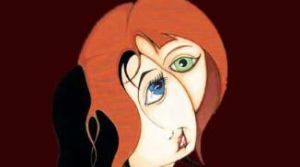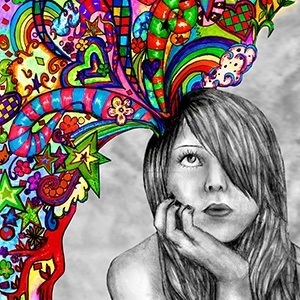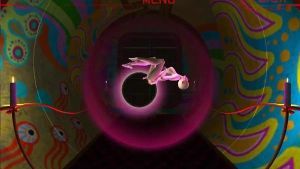 Oneiroid syndrome( another name - schizophrenic delirium) is called a psychopathological syndrome, in which there is a special impairment of consciousness, accompanied by hallucinations.
Oneiroid syndrome( another name - schizophrenic delirium) is called a psychopathological syndrome, in which there is a special impairment of consciousness, accompanied by hallucinations.
The very word "onyroid" comes from the Greek words "onyros"( dream) and "idos"( species).
Originally the term sounded like "onyric delirium".It was this name that was used by E. Regis in 1894.The next option - "onyeroid nonsense" - was proposed in 1909 by the French psychiatrist GG de Clermambo. The modern name appeared only in the 1920s.
Forms of disorder
There are 2 classifications of the syndrome. The affect is distinguished by depressive and expansive. In the first case, the patient often watches pictures of his own death or scenes of violence against his relatives. The main participants in these scenes are not only real, but also fictional people and fantastic creatures.
On the orientation in the surrounding world, the following kinds of oniroid are distinguished:
- Fantastic-illusory .This variety is observed in patients suffering from schizophrenia. With a fantastically illusory onyroid, there is a mixture of fragments of the picture of reality with elements of a fictional world accessible to only one patient. Hallucinations are superficial. The patient is detached from reality not completely, but only partially. Any object of the surrounding reality can become a kind of trigger mechanism, generating hallucinations.
- Dreamlike .It assumes complete detachment of the patient from the outside world due to immersion in his own fantastic visions. With this kind of violation, depersonalization can occur, loss of orientation in the real
 reality.
reality. - Scenically hallucinatory .It manifests itself in schizophrenia and senile psychosis. This type of syndrome assumes the most extensive spectrum of hallucinations: tactile, auditory, etc. Patients who have a scenically hallucinatory type of onyroid syndrome are not dangerous to surrounding people. Their delirium is characterized by fairy-tale, completeness and romanticism. Patients may be in psychomotor agitation.
- Oriented-dream .In most cases, this species is observed in exogenously-organic psychoses. This type of oniroid suggests affective states and vivid visual hallucinations.
Aggravating factors
Oneiroid syndrome most often accompanies one of the listed diseases and can be its consequence: schizophrenia, bipolar-affective disorder, psychoses, epilepsy, intoxications, paraphrenia. Visions can occur after traumas of the brain.
People who regularly use alcohol and psychoactive substances are affected by the syndrome. Especially often hallucinations occur with drug intoxication.
Oneyroidnye conditions are characteristic for the recurrent and catatonic forms of schizophrenia. The attack can last several days. In some cases, hallucinations last for months.
How it looks from within and from
The first symptoms of the syndrome can appear even at the age of 3-7 years. However, do not forget that for children there is a certain departure from reality, the perception of a fantastic world as real, etc.
That's why at this age it is difficult to make an accurate diagnosis and distinguish a serious illness from ordinary childhood fantasies. In younger schoolchildren, the symptoms can be manifested fragmentarily. Only an adolescent can make an accurate diagnosis. It is noted that in elderly people, the onyroid syndrome can be met infrequently.
The first disturbing symptom is a sharp change in mood. The patient can suddenly fall into depression or, conversely, into euphoria without objective reasons. Patients are often haunted by the fear of insanity. Those suffering from the onyroid complain of insomnia, which is replaced by bright dreams. The patient experiences headaches or in the heart area. One of the symptoms of the initial stage is  loss of appetite.
loss of appetite.
Delusions usually begin with a fear of death or persecution. Then there may be syndromes of Fregoli or Kapgra. In the first case, the patient perceives everyone around as his friend or relative, who constantly changes his appearance. In the second case, the patient is sure that someone from his relatives or even himself has been replaced by a double.
Attention should also be paid to those who begin to feel involved in the struggle between good and evil. Such a person usually claims that "good" characters( angels, God, etc.) send him positive messages, and "evil" characters( demons, demons, etc.) are negative messages.
With the advent of hallucinations, the patient begins to lose control over reality. If the control is lost only partially, the patient tries to take any actions that correspond to his visions, for example, he is sent to save the world at the request of the angel. With a complete loss of control over reality, the patient falls into a catatonic stupor, in which his consciousness is completely occupied with hallucinations.
The development of the disorder
Stages of the development of the syndrome:
- Disorder of the emotional sphere .At the first stage of the syndrome, the patient feels a sharp change in mood. The feeling of happiness can be replaced by apathy, which, in turn, gives way to impotence, fear and other negative emotions. Perhaps the predominance of only negative or only positive feelings.

- In the next stage the patient begins to experience the physical discomfort of : appetite worsens, insomnia appears.
- In the third stage it is already easy to notice speech and thinking disorder .The patient's speech becomes more and more incoherent and incomprehensible. This is due to the fact that the patient begins to torment visions, which he is not always able to describe. At this stage, the patient has not completely lost control of reality, but he is already beginning to experience disorientation in time and space.
- In the next stage is possible to completely escape the reality of , when the patient begins to see a dream in reality. However, despite the fact that in reality the patient is in a state of numbness, in his hallucinations he can be an active participant in certain events. When you exit from the oneiroid state, the patient often experiences partial amnesia.
Consequences for themselves and others
 People who suffer from a syndrome of the syndrome are not always dangerous to others. Nevertheless, at the first signs of the problem, it is necessary to immediately contact a specialist.
People who suffer from a syndrome of the syndrome are not always dangerous to others. Nevertheless, at the first signs of the problem, it is necessary to immediately contact a specialist.
Having lost the orientation in time and space, a person can become dangerous not so much for his environment as for himself.
Hallucinations can cause it to act accordingly. Having received the "order" from the light forces, the patient can try to destroy his relative, in which he will see the enemy.
Prophylaxis and treatment of
Any independent treatment of oniroid should be completely ruled out. If visions are caused by the use of alcohol or narcotic substances, the patient must get rid of the bad habit under the supervision of the attending physician and undergo the prescribed treatment.
The best prevention in this case is the refusal even of occasional use of the substance that caused the onyroid syndrome.
In cases where management is associated with a mental illness, the patient will have even more serious complex treatment in a psychiatric clinic. In addition to the main therapy, the doctor can prescribe a symptomatic one. Most complex treatment includes 3 main components: 
- Nootropic drugs .Drugs of this group have a positive effect on the vegetative system and conditioned reflexes. The tasks of nootropics include the restoration of brain activity, impaired disease, and memory improvement.
- Neuroleptic drugs .They are called to maintain emotional stability and to suppress hallucinations.
- Electroconvulsive therapy .This method is not always used. Many specialists prefer to address him only in the most extreme cases. Electroconvulsive therapy has a number of contraindications. Nevertheless, its effectiveness was confirmed in the treatment of hundreds of patients.
As a prophylaxis, the patient should regularly undergo a checkup from his or her attending physician, especially if he has been diagnosed with schizophrenia.



